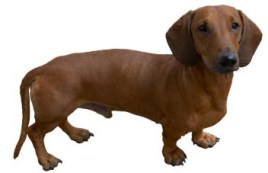
Not human bean, more than a human been!
 The size
The size
Breed characteristics were determined over 100 years ago. Since then many changes have been made through breeding. Today standards have been set forth by the German Dachshund Club (DTK) and the American Kennel Club.
Dachshunds come in three sizes: standard and miniature, and kaninchen.
Although the first two sizes are recognized almost universally, the
third size (which means rabbit) is recognized only by non-English
speaking clubs like the Fédération Cynologique Internationale (World
Canine Federation)
A full-grown standard dachshund averages 16 lb (7.3 kg) to 28 lb (13
kg), while the miniature variety normally weighs less than 11 lb (5.0
kg) with a chest up to 14 inches around. The kaninchen weighs 8 lb (3.6
kg) to 10 lb (4.5 kg) with chests measuring up to 12 inches around.
According to most kennel club standards, the miniature (and kaninchen,
where recognized) variety differs from the full-size only by size and
weight, thus offspring from miniature parents must never weigh more than
the miniature standard to be considered a miniature as well.
 "A dachshund is a half-dog high and a dog-and-a-half long,"
"A dachshund is a half-dog high and a dog-and-a-half long,"

Their head taper uniformly to the tip of the nose. Their eyes are medium sized, dark and almond shaped, with dark rims. Their ears are set near the top of their heads, are rounded and moderately long. The flopping down of the ears was intentionally bred into the dog to prevent their ears from getting filled with dirt and other debris while they were hunting under the ground. Their lips are tightly stretched and they have strongly developed teeth that fit closely together in a scissors bite. Their teeth are exceptionally strong for a dog of their size.
The Dachshund has a long muscular neck that flows gracefully into their shoulders. Their trunks are exceptionally long and very muscular. Their bodies hang low to the ground, but should not be loose.
Their front legs are very strong, as they were built for flushing animals out of burrows. They have very tight and compact front feet with well arched toes and tough, thick pads. Their hind legs are very well muscled with strong and powerful thighs. Their hind feet are smaller than their front feet. They have a long and rounded croup that sinks slightly toward the tail. Their tails are set in and have no pronounced curving.
Here you can see picture of: Diagram of Dachshund in show Pose, Technical Terms and Summary of Standard of Perfection.
